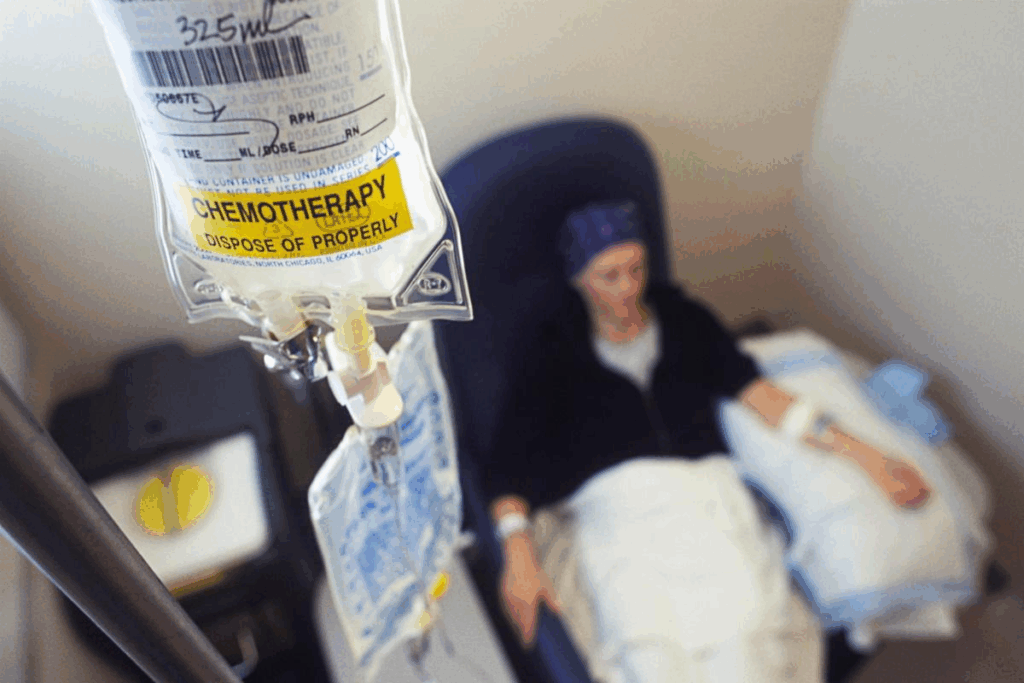
Getting a diagnosis of a benign tumor can be confusing.chemo for non cancerous tumorCan stem cells be cancerous? There are many treatment options to choose from. At Liv Hospital, we get how unsure you might feel about what to do next.
Chemotherapy is often linked with cancer treatment. But its use in treating benign tumors is not as clear-cut.
We are committed to providing clarity and compassion as you navigate this complex situation. Our team is dedicated to delivering personalized care. We also offer access to the latest evidence-based therapies for patients with benign tumors.
In some rare cases, chemotherapy might be considered for certain benign tumors.

Benign tumors are non-cancerous growths that don’t spread to other tissues. They are usually not dangerous and are often found by chance during medical checks.
A benign tumor doesn’t spread to other parts of the body. Benign tumor definition includes growths that are usually contained and grow slowly.
The definition of benign tumor is key to telling it apart from cancerous tumors. Cancerous tumors can spread and invade tissues.
There are many types of benign tumors, including:
These tumors can appear almost anywhere in the body. They are named based on the tissue or cell type they come from.
Benign tumors grow slowly. A benign tumor grows slowly and stays in one place. This is different from cancerous tumors, which grow fast and spread.
| Characteristics | Benign Tumors | Malignant Tumors |
| Growth Rate | Slow | Rapid |
| Invasion | Localized | Invasive |
| Metastasis | No | Yes |

It’s important to know the difference between benign and malignant tumors. Benign tumors are not cancerous and don’t spread. Malignant tumors are cancerous and can spread to other parts of the body.
Benign tumors grow slowly and don’t invade nearby tissues. Malignant tumors grow fast and invade tissues, causing problems. Benign tumors look like normal cells, while malignant tumors don’t.
Malignant tumors can spread to other parts of the body, which is dangerous. They can also harm vital organs by invading them. This makes malignant tumors very serious.
| Characteristics | Benign Tumors | Malignant Tumors |
| Growth Rate | Slow | Rapid |
| Invasion | Do not invade surrounding tissues | Invade surrounding tissues |
| Metastasis | Do not metastasize | Can metastasize |
| Cell Differentiation | Well-differentiated | Poorly differentiated |
Imaging studies and biopsy are key for telling benign from malignant tumors. Imaging shows the tumor’s size and location. Biopsy examines tumor tissue to see its cells.
These methods help us figure out if a tumor is benign or malignant. Knowing this helps us plan the best treatment. We aim to give patients the right care by understanding these differences.
It’s important to know when to seek medical help for benign tumors. These growths are not cancerous but can cause issues. Their size, location, and how fast they grow matter a lot.
Whether a benign tumor is causing symptoms affects treatment decisions. Symptomatic benign tumors cause pain or discomfort. For example, a brain tumor might lead to neurological problems, while an abdominal tumor could affect digestion.
Asymptomatic benign tumors don’t cause symptoms and are often found by chance. These tumors are usually monitored but not immediately treated.
The location of a benign tumor is key in deciding treatment. Tumors in critical areas, like the brain or near vital organs, might need treatment even without symptoms. This is because they could cause serious problems or affect organ function.
For instance, a tumor near a nerve or blood vessel might need removal to avoid damage. We look at the tumor’s location and its possible effects on nearby tissues when planning treatment.
Benign tumors usually grow slowly, but some can grow fast. The growth rate is important for deciding if treatment is needed. Rapidly growing benign tumors might need quicker action to manage symptoms and prevent complications.
We track the growth of benign tumors through regular checks and imaging. If a tumor grows fast, we might consider surgery or other treatments to control symptoms and prevent further issues.
There’s a worry that benign tumors could turn cancerous. While most don’t, some types can become cancerous over time. This risk depends on the tumor type, location, and other factors.
For example, some benign colon tumors can turn into colorectal cancer if not treated. We evaluate the risk of turning cancerous based on the tumor’s type, location, and other factors.
Conventional Treatment Approaches for Benign Tumors
Benign tumors can be treated in different ways. Each method has its own benefits and things to consider. The right treatment depends on the tumor’s size, where it is, and any symptoms it causes.
For many benign tumors, the first step is watchful waiting or active surveillance. This means checking the tumor with imaging tests regularly. It’s often suggested for small, symptom-free tumors.
Watchful waiting is good for tumors that are likely to stay benign and not harm you. For example, some thyroid nodules don’t need treatment right away. They just need to be watched to make sure they don’t grow or cause problems.
Surgery is often used for benign tumors that cause symptoms or are too big. The goal is to remove the tumor and some of the surrounding tissue. This helps make sure all tumor cells are gone.
For instance, surgery is often needed for big or uncomfortable benign breast tumors. The surgery is done under general anesthesia. How long you need to recover depends on how big the surgery was.
How to treat benign tumors depends on the type and where it is. For some, like lipomas, surgery is usually the best choice. For others, like some liver tumors, a more careful approach might be better.
Minimally invasive procedures are becoming more common for treating benign tumors. These methods use small cuts and special tools to remove the tumor. They help you recover faster and leave less scar.
Examples include laparoscopic surgery and radiofrequency ablation. These are used for tumors in places like the liver, kidney, and uterus.
| Treatment Option | Description | Benefits |
| Watchful Waiting | Regular monitoring with imaging tests | Avoids unnecessary surgery, reduces risk of complications |
| Surgical Removal | Removing the tumor surgically | Effective for symptomatic tumors, provides tissue for diagnosis |
| Minimally Invasive Procedures | Using small incisions and specialized instruments | Reduces recovery time, less scarring, less risk of complications |
Chemotherapy is often linked with cancer treatment. Yet, it can also treat non-cancerous tumors in some cases. It’s not usually the first choice for benign tumors. But, there are times when it might be considered.
Chemotherapy is mainly for benign tumors that can’t be removed by surgery. It’s also used for tumors that come back after surgery or cause a lot of symptoms. For example, some benign tumors with a lot of blood vessels or a high risk of bleeding might shrink with chemotherapy.
Doctors say chemotherapy can help certain benign tumors that don’t respond to other treatments. This choice is made on a case-by-case basis. It depends on the tumor, the patient’s health, and the treatment’s benefits and risks.
Some benign tumors might get better with chemotherapy. These include:
These tumors might not get better with usual treatments. So, chemotherapy could be an option.
Chemotherapy plans for benign tumors vary. They depend on the tumor’s type, size, and where it is. Treatments can use one drug or a mix, lasting from months to years.
| Tumor Type | Chemotherapy Protocol | Duration |
| Desmoid Tumors | Low-dose methotrexate and vinblastine | 1-2 years |
| Benign Vascular Tumors | Propranolol and corticosteroids | Several months |
Thinking about chemotherapy for benign tumors means looking at the good and bad sides. It can shrink tumors and ease symptoms. But, it can also cause tiredness, nausea, and hair loss.
“The decision to use chemotherapy for a benign tumor should be made on a case-by-case basis, taking into account the tumor’s characteristics, the patient’s overall health, and the possible benefits and risks of treatment.”
We work closely with our patients to find the best treatment. We make sure they get all the care they need during treatment.
Medication is key in managing benign tumors, providing non-surgical solutions. Many patients seek alternatives to surgery. There are several medication-based treatments available.
Hormone therapy is used for benign tumors that respond to hormones. It blocks or reduces hormone production that fuels tumor growth.
For example, uterine fibroids grow due to estrogen. Hormone therapy can reduce estrogen levels, shrinking these tumors.
Several medical methods can quickly shrink benign tumors. Medications that target the tumor’s blood supply are effective.
Another method uses medications that target tumor cells directly. The right treatment depends on the tumor’s type and location.
Anti-inflammatory medications help with symptoms like pain and swelling from benign tumors. They reduce inflammation around the tumor.
In some cases, these medications can also shrink the tumor by reducing growth factors.
Research is ongoing for benign neoplasm treatment, with new approaches emerging. Targeted therapies aim at specific molecular mechanisms of tumor growth.
As we learn more about benign tumors, treatment options improve. New therapies offer hope for non-surgical management of benign tumors.
The treatment options for benign tumors have grown. Now, we have radiation and new therapies. These options bring hope to those with benign tumors.
Stereotactic radiosurgery is a precise radiation therapy. It focuses radiation on the tumor, protecting nearby tissue. It’s great for tumors that are hard to reach or near important areas.
Conventional radiation therapy uses many sessions over time. It works well for tumors that radiation can kill. It’s a good choice for those who can’t have surgery.
Cryotherapy freezes tumor cells, killing them. Thermal ablation uses heat to destroy tumor tissue. Both are less invasive and can treat some benign tumors.
Embolization blocks the tumor’s blood supply. This can make the tumor shrink or disappear. It’s best for vascular tumors.
| Therapy | Description | Benefits |
| Stereotactic Radiosurgery | Precise radiation delivery | Minimal damage to surrounding tissue |
| Conventional Radiation | Multiple sessions over time | Effective for radiation-sensitive tumors |
| Cryotherapy | Freezing tumor cells | Minimally invasive, effective for certain tumors |
| Embolization | Cutting off tumor blood supply | Can lead to tumor shrinkage or disappearance |
We’ve looked at advanced treatments for benign tumors, like radiation and other minimally invasive methods. These options give patients choices based on their needs.
Understanding the recovery process and follow-up care is key for patients after benign tumor treatment. At Liv Hospital, we focus on patient-centered care. We ensure our patients get the support they need during their recovery.
The recovery time after benign tumor treatment varies. It depends on the treatment type, tumor size and location, and the patient’s health. Generally, recovery takes several weeks to a few months. It’s important to follow the post-treatment instructions given by your healthcare team for the best healing.
Key factors influencing recovery timelines include:
Follow-up care is vital for recovery. At Liv Hospital, we have strict follow-up protocols. We monitor our patients’ progress and address any concerns quickly. The frequency and nature of follow-up appointments vary, but they include:
| Follow-Up Activity | Frequency | Purpose |
| Post-treatment check-ups | Every 1-3 months | To monitor healing and address any complications |
| Imaging tests (e.g., MRI, CT scans) | As needed, based on initial treatment and patient condition | To assess the treated area and detect any possible recurrence |
| Laboratory tests | As required, based on treatment type and patient health | To monitor overall health and detect any adverse effects of treatment |
At Liv Hospital, we focus on patient-centered care. We address each patient’s unique needs and concerns. Our team works closely with patients to create personalized treatment plans and provide ongoing support.
“Our patients’ well-being is our top priority. We strive to create a supportive and caring environment that fosters healing and recovery.”
We follow international treatment standards and use evidence-based therapies. This ensures our patients receive the best care. Our commitment to medical advancements means our patients benefit from the latest in benign tumor treatment.
By combining cutting-edge treatments with compassionate care, we empower our patients. We help them achieve the best outcomes and improve their quality of life.
Choosing the right treatment for benign tumors is key to good health. We’ve looked at what benign tumors are, their types, and how to treat them. This knowledge helps patients make smart choices.
Liv Hospital focuses on caring for patients and using proven treatments. Our team helps patients pick the best treatment. This could be watching the tumor, removing it surgically, or other methods.
It’s important for patients to know their treatment options. By looking at the tumor’s type, where it is, and how fast it grows, patients can work with doctors. Together, they can create a treatment plan that fits the patient’s needs.
We urge patients to be involved in their care. Ask questions and get a second opinion if needed. This way, patients can get the best treatment for their situation.
A benign tumor is a non-cancerous growth. It doesn’t invade surrounding tissues or spread to other parts of the body.
Benign tumors grow slowly and stay in one place. They are different from malignant tumors, which grow fast and spread.
Yes, though rare, some benign tumors can turn cancerous. This is why it’s important to watch them closely and get medical checks.
Treatments for benign tumors include watching them, surgery, and other procedures. Hormone therapy and radiation therapy might also be used, depending on the tumor.
Chemotherapy is not usually used for benign tumors. But, it might be considered if the tumor is causing big problems or could turn cancerous.
To shrink benign tumors fast, doctors might use hormone therapy or anti-inflammatory drugs. The choice depends on the tumor’s type and how it behaves.
Benign tumors are non-cancerous and don’t spread. Malignant tumors are cancerous and can spread and invade tissues.
No, not all tumors are cancerous. Benign tumors are non-cancerous and don’t spread or invade tissues.
Recovery times and follow-up plans vary. Liv Hospital offers care and therapies that support recovery, based on the treatment and tumor type.
While most benign tumors grow slowly, some can grow fast. This shows why it’s key to get medical checks and watch them closely.
Benign tumors can cause symptoms and press on nearby tissues. They can also turn cancerous, so it’s important to get them checked and treated.
No, a benign tumor is not cancer. It’s a non-cancerous growth that doesn’t spread or invade tissues.
Subscribe to our e-newsletter to stay informed about the latest innovations in the world of health and exclusive offers!
WhatsApp us